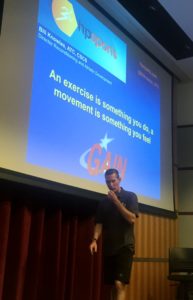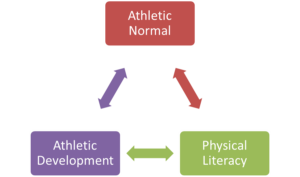Reconditioning athletes: Bill Knowles seminar
“An exercise is something you do a movement is something you feel.”
Was the title of Bill Knowles’ seminar on rehabilitating (reconditioning in his terms) athletes from sports injuries.
The question he asks himself is “what’s in the best interest of the athlete?” This often means pulling the athlete out of the injured body and getting them to recognise their athletic spirit again. All too often in rehab settings, the focus of the treatment is on the injured part, rather than on the person (see previous seminar)
Once you recognise that the entire body is supporting the injured knee then your perspective on getting the athlete back to competition changes.
A few key considerations on rehabilitation
Bill outlined some of his principles that underpin his approach to reconditioning.
- Rate of force acceptance (deceleration) vs rate of force development (acceleration). The latter is much talked about and measured, the former is where injuries often occur.
- Rehabilitation (medical model) vs reconditioning (performance model)
We are looking to get back to performance so we need to think about this from the onset (I will use the term reconditioning from herein).
- “We have to stay professionally stimulated” as improving the journey helps athletes. (It’s hard to stay professionally stimulated if you are handing out photocopied sheets of paper with “3 sets of 10” for each exercise for every person who walks into your clinic).
This then encourages us to think of more athletic ways to train. A good way to start improving the journey is through a movement that is familiar to the athlete. Bill showed a video clip of an athlete very soon post injury, who was walking in water with a knee brace and even did some low level bouncing).
The restoration of athletic normal
We are looking to prepare the athlete for return to play whilst also addressing their injury.
Physical literacy, athletic development and athletic normal are all linked and form part of a “training based prevention”.
Compare that to a medical intervention led prevention strategy with exercises which mean they are “just doing stuff”.
“Training is through movement, not simplistic exercises.”
Our aim is “The ability to move efficiently in an athletic environment with precision style and grace.” We can “start encouraging biological healing through movement.”This exercise has the added benefit of encouraging sleeping which of course is a great healer.
If you just look at things from as sports medicine perspective, you might be satisfied with an injury that is healed. However, “just because you are biologically healed, does not mean you are athletically prepared.”
Bill then quoted Carol Welch: “movement is medicine for creating change in a person’s physical, emotional and mental states”.
Followed by Plato: “Lack of activity destroys the good condition”.
The athlete must not forget what is natural and simple (to them) so this must be incorporated into their reconditioning programme.
A “protection mindset” contributes to complexity. This is unnatural and may add no enhanced healing quality if it compromises movement quality.
Rebuilding the formula one car
Bill used a great analogy when looking at reconditioning. If your Ferrari formula one car is broken into pieces, you can attempt to rebuild it and end up with a red porsche. You have ended up with a fast red car, but it isn’t a formula one car.
You have to know what the athlete looks like at the end. “I’m not interested in restoration of jogging, I’m interested in the restoration of acceleration, deceleration and change of direction.”
Movement is so simple and yet so complex. Many clinicians prescribe exercises and restrict on other movements because they are uncomfortable with movement.
(I know one physio whose end stage acl rehab was chatting to a footballer who was jogging on a treadmill! That was his “return to play” assessment).
I have seen Bill present many times now since 2011 with several practical workshops too. He has given me the confidence to both discuss sports injury with clinicians and also work with athletes on reconditioning their serious injuries.
(It helps that I can share ideas with my wife Sarah who is a Chartered Physiotherapist who has developed her knowledge of movement by becoming a level 1 strength and conditioning coach).
Bill is a fine example of the GAIN faculty and attendees who learn from the different people and return to their settings to apply, innovate and develop their knowledge in order to help their athletes.
I also spent an hour discussing ACL reconditioning and using the 4Dpro with athletes over dinner with Bill. This was very enlightening and will help the athletes I work with here in Devon: thanks Bill!
Further Reading:
- Dr Mike Joyner on Sports Science: Servant or Master?
- Bill Knowles on Planned Performance Training






I see Bill Knowles has been working with Andy Murray. In the video I can see he has used some of your gymnastics ideas. Did you share them at GAIN?
I wouldn’t say Bill has used my ideas, we both use gymnastics movements in our training.
No one has a copyright on how the body works.
I have learnt plenty of principles and ideas from Bill over the last 9 years, but we both get ideas from GAIN and elsewhere.
I came across Bill recently, as two of our local football players at Bournemouth are visiting him for ACL rehab. I can’t find any journal articles or research of bills on knee work. Can you list any here if you have found any?
Also, I’m struggling to see how this breaks the mould from a pretty basic concept i.e, treat the injury, heal the injury, sports specific rehab on the injury. From what I can see it just seems like it is pretty much just using basic terms in sports rehab which are already a thing and just coupled with fancied americanised concepts to better describe the process of physio then sports specific S&C coaching, which is already a thing. Help me understand what separates bill from this…if at all it does or is supposed to….
Thanks for your time
I can’t comment on your experiences with rehab, as I don’t know what they are.
If you think that Bill Knowles’ super rehab skills are just “fancied Americanised concepts” then I need to do a better job of writing.
I was with Bill for another week at GAIN last month, we talked and discussed rehab and shared ideas. There are many good people out there, Bill is excellent at what he does.
There are also many people who do not understand what it means and takes to integrate motor learning, skill development, injury rehabilitation and sound coaching.